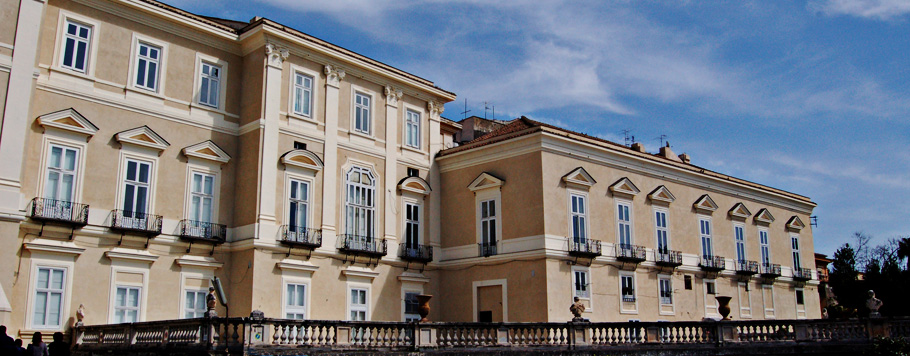 un progetto di
un progetto di 
La reggia di Portici, a tre piani, è la residenza estiva della famiglia reale borbonica, e della sua corte, voluta dal re di Napoli, Carlo di Borbone nel 1738. Il progetto fu affidato a Giovanni Medrano e, successivamente, a Luigi Vanvitelli. Oltre alla residenza venne realizzato il parco: un giardino all’inglese che degrada verso il mare con numerose statue e fontane e un anfiteatro. La realizzazione di questa reggia portò alla scoperta di numerosi reperti archeologici, tanto che il re decide di creare un Museo per inserire tutti gli oggetti rinvenuti dagli scavi. Tra le realizzazioni più preziose si conserva il salottino di porcellana della Regina Maria Amalia (oggi al museo di Capodimonte). Nel 1799, con la rivoluzione napoletana, la Reggia fu abbandonata e derubata di numerose opere. Con il dominio francese di Gioacchino Murat ci furono dei rinnovi delle decorazioni secondo il gusto del tempo, soprattutto per quello che riguarda gli arredi; inoltre in questo periodo vennero trasferite le antichità rimanenti al Museo di Napoli. Intorno al 1870, con Ferdinando II di Borbone la reggia fu collegata alla città con una ferrovia, primo caso in Europa. Nello stesso periodo fu aggiunto un orto botanico composto da due ampi giardini, serre, vivai e laboratori per lo studio delle piante. Oltre il giardino si estendeva un bosco in cui i nobili si svagavano col il “gioco del pallone” o “delle fortificazioni”. Oggi la Reggia ospita la sede della Facoltà di Agraria dell’Università di Napoli.
The palace of Portici, with three floors, is the summer residence of the Bourbon royal family, and his court, commissioned by the King of Naples, Charles of Bourbon in 1738. The project was entrusted to Giovanni Medrano and later to Luigi Vanvitelli. In addition to the residence it was built the park: an English garden that slopes towards the sea with numerous statues and fountains and an amphitheater. The realization of this palace led to the discovery of numerous archaeological finds, and the king decided to create a museum to put all the items found in the excavations. Among the most precious achievements it will keep the porcelain sitting room of Queen Maria Amalia (now in the Capodimonte Museum). In 1799, with the Neapolitan revolution, the palace was abandoned and robbed of numerous works. With the French rule of Joachim Murat, there were renewals of the decorations in the style of the time, especially for what concerns the furnishings; Also in this period they were transferred to the remaining antiquities in the Museum of Naples. Around 1870, with Ferdinand II the palace was connected to the town with a railroad, the first case in Europe. In the same period it was added a botanical garden consists of two large gardens, greenhouses, nurseries and laboratories for the study of plants. Beyond the garden it stretched a forest in which the nobles svagavano with the "game ball" or "fortifications". Today the Palace houses the headquarters of the Faculty of Agriculture, University of Naples.
Contatti
Palazzo Reale
Via Università, 101
80055 Portici (NA)
Informazioni generali
E-mail: segreteria@centromusa.it
Web: centromusa.it
realcasadiborbone.it